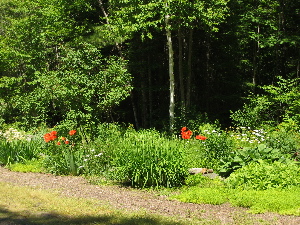BASIC GARDENING VOCABULARY (P-Z)
Here is the rest of the most basic gardening vocabulary you'll ever need. This bunch is from "P-Z", and constitutes the end of the list.
Again if there's a word you think belongs here, let me know...
• peat- formed by partial decomposition in water of various plants (as mosses of the genus Sphagnum)
• perennials- appearing again and again; recurrent; generally it is a plant living three or more years.
• pesticide-substances that protect plants against molds, fungi, and insects. The term pesticide refers to all pest control substances, including insecticides, herbicides, and fungicides.
• pH- a measure of acidity and alkalinity that is a number on a scale where 7 represents neutrality and lower numbers indicate increasing acidity and higher numbers increasing alkalinity
• phosphorus-a major element in plant nutrition which supplies food to roots, fruit and helps with disease resistance.
• pinching- to prune the tip of (a plant or shoot) usually to induce branching
• pollinator- an insect that pollinates flowers
• potash-good stuff helping plants resist disease while protecting them during drought and cold.
• potassium-also called potash
• propagation-reproduction of plants
• pruning- to cut off or cut back parts of a bush or tree to create a more pleasing shape or to produce more fruitful growth
• pruning saw- A saw with a relatively long and narrow cutting blade that can get into tight places
• rhizomes- a somewhat long usually horizontal subterranean plant stem that is often thickened by deposits of reserve food material, produces shoots above and roots below, and is distinguished from a true root in that it has buds and nodes
• rock garden- a garden planned around natural rock formations or rocks artificially arranged to simulate natural (often mountainous) conditions
• rotation- Rotation is a gardening practice where different plants are placed in a certain section of the garden each year.
• separating-a version of propagation when plants are divided
• shrub- a low usually several-stemmed woody plant
• soil-the top layer of the earth's surface in which the roots of plants develop. It provides the plants with the necessary nutrients, water and gases. There are many more things in soil, but this is enough for now.
• succulents- Having thick, fleshy, water-storing leaves or stems
• sucker- a shoot from the roots or lower part of the stem of a plant
• tender- Sensitive to frost or severe cold and not hardy
• transplant- to lift and reset (a plant) in another place
• variegated- leaves having streaks, marks, or patches of a different color or colors
• water garden- Any ornamental tub, pool, or other natural or artificial water container planted with aquatic plants.
• weed-any plant growing where it's NOT wanted
• zone- The contiguous United States and southern Canada are divided into 10 zones based on a 10 F (5.6 C) difference in average annual minimum temperature.





3 Comments:
I notice you included "shrub" but not vine or tree. (I hate when people call shrubs "bushes", by the way). Tree and vine may be too obvious, but it makes it more complete. Trees, shrubs, and vines...
I somehow think folks will know what a vine or tree is, but a shrub...who knows? They may want to call it a "bush"! :-) Remember, I want the list as compact as possible.
I think this a great list. I don't know much about gardening, but I am trying to learn and this list has given me a great start. Thanks for the information!
Post a Comment
<< Home